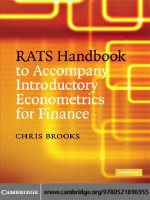cambridge university press commercial agreements and social dynamics in medieval genoa apr 2009 kho tài liệu bách khoa
Bạn đang xem bản rút gọn của tài liệu. Xem và tải ngay bản đầy đủ của tài liệu tại đây (2.42 MB, 280 trang )
This page intentionally left blank
Commercial Agreements and Social Dynamics
in Medieval Genoa
Commercial Agreements and Social Dynamics in Medieval Genoa is
an empirical study of medieval long-distance trade agreements and the
surrounding social dynamics that transformed the feudal organization
of men-of-arms into the world of Renaissance merchants. Making use
of 20,000 notarial records, the book traces the commercial partnerships
of thousands of people in Genoa from 1150 to 1435 and reports social
activity, on a scale that is unprecedented for such an early period of
history anywhere.
In combining a detailed historical reading with network modeling
to analyze the change in the long-distance trade relationships, Quentin
Van Doosselaere challenges the prevailing Western-centric view of
development by demonstrating that the history of the three main
medieval economic frameworks that brought about European capitalism – equity, credit, and insurance – was not driven by strategic
merchants’ economic optimizations but rather by a change in partners’
selections that reflected the dynamic of the social structure as a whole.
Dr. Quentin Van Doosselaere is a Research Fellow at Nuffield College.
He combines training in sociology and business administration to focus
on the emergence of capitalism at the end of the medieval period.
Adding formal network analysis tools to detailed archival research,
Dr. Van Doosselaere has studied the social foundations underpinning
the economic changes that initiated the Western dominance in global
economic exchange. The multidisciplinary nature of his research has
resulted in invitations to present his work to Business, Economics,
History, and Sociology Departments in both Europe and the United
States.
Commercial Agreements and Social
Dynamics in Medieval Genoa
QUENTIN VAN DOOSSELAERE
Nuffield College, Oxford University
CAMBRIDGE UNIVERSITY PRESS
Cambridge, New York, Melbourne, Madrid, Cape Town, Singapore, São Paulo
Cambridge University Press
The Edinburgh Building, Cambridge CB2 8RU, UK
Published in the United States of America by Cambridge University Press, New York
www.cambridge.org
Information on this title: www.cambridge.org/9780521897921
© Quentin Van Doosselaere 2009
This publication is in copyright. Subject to statutory exception and to the
provision of relevant collective licensing agreements, no reproduction of any part
may take place without the written permission of Cambridge University Press.
First published in print format 2009
ISBN-13
978-0-511-51790-7
eBook (NetLibrary)
ISBN-13
978-0-521-89792-1
hardback
Cambridge University Press has no responsibility for the persistence or accuracy
of urls for external or third-party internet websites referred to in this publication,
and does not guarantee that any content on such websites is, or will remain,
accurate or appropriate.
To my Rise¨. May she overcome the odds.
Contents
List of Figures
List of Tables
Abbreviations
Acknowledgments
page ix
xi
xiii
xv
1
From Sword into Capital
2
Genoa at the Dawn of the Commercial Expansion
2.1 The Feudal Commune
2.2 Genoa and Medieval Trade to 1150
2.3 Linking Two Worlds
Equity Partnerships for Heterogeneous Ties
3.1 Commenda: A Staple Framework for Occasional
Partners
3.2 Januensis Ergo Mercator: The Multivalent Genoese
3.3 Network Dynamics: From Clientelism to
Corporatism
Credit Network for Routinized Merchants
4.1 Medieval Credit Instruments
4.2 Credit Network for Regular Traders
4.3 Merchants
Insurance Ties for Oligarchic Cohesion
5.1 Genoese Clans
5.2 Third-Party Insurance
5.3 Oligarchic Families
118
123
139
148
170
176
182
194
Conclusion
208
3
4
5
6
1
25
26
45
57
61
63
78
100
vii
viii
Contents
Appendix A: Sample of Prices and Income
215
Appendix B: Sample of Long-Distance Trade
Participants’ Occupations
Appendix C: Commenda Network Graphs
217
219
Appendix D: Nodal Degree Distributions of
Commenda Networks
Appendix E: List of Top Mercantile Nonaristocratic Families
223
225
Appendix F: Partner Selection Probability Model
227
Bibliography
Index
233
255
List of Figures
3.1 Average commenda value (per tie) by gender
page 84
3.2 Percentage of commendae including at least one woman
85
3.3 Average commenda value in three selected
occupational groups, 1182–1315
91
3.4 Aristocrats’ participation in commenda networks
94
3.5 Families’ political appointments and commenda ties,
1154–1295
99
3.6 Commenda network, 1198–1215
102
3.7 An ideal type of feudal social organization
105
3.8 Degree centralization in commenda networks, 1154–1315
106
3.9 Commenda network, 1154–64
107
3.10 Commenda network, 1296–1315
108
3.11 Centralization and connectedness indices,
commenda network, 1154–1315
110
3.12 Network centralization, connectedness, and status
homophily, 1154–1315
114
3.13 Occupational homophily (S14) for three selected groups
116
4.1 Artisans’ and professionals’ combined share of the
long-distance trade network population, 1154–1355
141
4.2 Comparison of career lengths of credit and noncredit
users among all long-distance operators, 1154–1399
145
4.3 Comparison of career lengths of credit and noncredit
users among routinized long-distance traders, 1154–1399
146
4.4 Credit network density, 1154–1355
148
4.5 Percentage of network ties involving aristocrats, 1154–1400 165
5.1 Percentage of intrafamily ties in the Genoese
long-distance trade network, 1154–1315
178
5.2 Insurance network, 1410–35
195
ix
x
C.1
C.2
C.3
C.4
C.5
C.6
F.1
F.2
List of Figures
Commenda network, 1154–64
Commenda network, 1182–97
Commenda network, 1215–39
Commenda network, 1245–68
Commenda network, 1269–95
Commenda network, 1296–1315
Probability distribution of number of individual
underwriting families for thirty insurance coverages
Cumulative probability distribution for the insurance
sample and for the uniform distribution (0,1)
219
220
220
221
221
222
228
231
List of Tables
3.1
3.2
4.1
4.2
4.3
4.4
5.1
5.2
F.1
Average commenda trade volume per family according
to change in consular appointments
Value of S14 for status homophily, 1154–1315
Credit data set, 1154–1406
Density ratio between credit and commenda networks,
1154–1315
Percentage of long-distance trade volume involving
one or more Ligurians, 1154–1355
Closures index (S14) for homophilic credit partner
selections, 1300–1400
Frequency distribution of risk amount underwritten
per individual per contract, 1427–31
Density matrix for insurance network’s core/periphery
bipartition (1410–35)
Insurance partner selection distribution
page 98
113
125
147
151
168
189
198
229
xi
Abbreviations
Currency
£
FL
Genoese pound
Genoese florin
Unpublished Primary Sources
BA
JE
Balard, Michel. Unpublished transcripts of notarial records.
References in Balard, Michel. 1978. La Romanie Ge´noise:
XIIe`me-de´but du XVe`me sie`cle. Rome: E´cole franc¸aise de
Rome, pp. 678–82.
Jehel, Georges. Unpublished transcripts of notarial records.
References in Jehel, Georges. 1993. Les Ge´nois en
Me´diterrane´e occidentale (fin XIe`me – de´but XIVe`me sie`cle):
e´bauche d’une strate´gie pour un empire. Amiens: Centre
d’histoire des socie´te´s Universite´ de Picardie, pp. 480–2.
Published Primary Sources
Annales
BO1
1
Airaldi, Gabriella. 2002. Gli annali di Caffaro: 1099–1163.
Genoa: Fratelli Frilli
Eierman, Joyce E., Hilmar C. Kruger, and Robert L. Reynolds
(Eds.). 1939. Bonvillano. Turin: S. Lattes.
The number that follows each abbreviation in the text refers the number of a specific
notarial record and the date when (month and year) the record was minuted. For example,
the abbreviation BO#224/December 1198 refers to the notarial record number 224
minuted in December 1198 by the notary Bonvillano as it was classified by Eierman,
Kruger, and Reynolds (1939).
xiii
xiv
Abbreviations
CA
Hall, Margaret, Hilmar C. Kruger, Renert G. Ruth, and
Robert L. Reynolds (Eds.). 1938. Guglielmo Cassinese. Turin:
S. Lattes.
Imperiale di Sant’ Angelo, Cesare, and Genoa (Republic).
1936, 1938, and 1942. Codice diplomatico della republica di
Genova, I–III. Rome: Tipografia del Senato.
Doehaerd, Rene´e. 1941. Les Relations commerciales entre
Geˆnes, la Belgique et l’Outremont, d’apre`s les archives
notariales ge´noises aux XIIIe`me et XIVe`me sie`cles. Brussels:
Academica Belgica.
Hall-Cole, Margaret, Hilmar C. Kruger, Ruth G. Renert, and
Robert L. Reynolds (Eds.). 1939. Giovanni di Guiberto.
Turin: S. Lattes.
Doehaerd, Rene´e, and Charles Kerremans. 1952. Les
Relations commerciales entre Geˆnes, la Belgique et
l’Outremont, d’apre`s les archives notariales ge´noises,
1400–1440. Brussels: Academica Belgica.
Krueger, Hilmar C., and Robert L. Reynolds (Eds.). 1951–53.
Lanfranco. Genoa: Societa Ligure di Storia Patria.
Lopez, Roberts. 1953. “L’activita` economica di Genova nel
Marzo 1253 secondo li atti notarili del tempo.” ASLI 54:
163–270.
Bach, Erik. 1955. “Mercato Oberto Scriba de.” In La cite´ de
Geˆnes au XIIe`me sie`cle, pp.150–76. Copenhagen:
Gyldendalske boghandel.
Chiaudano, Mario, and R. M. della Rocca (Eds.). 1940.
Oberto Scriba de Mercato, 1186. Turin: S. Lattes.
Chiaudano, Mario, and R. M. della Rocca (Eds.). 1938.
Oberto Scriba de Mercato, 1190. Turin: S. Lattes.
Chiaudano, Mario, and Mattia Moresco (Eds.). 1935. Il
cartolare di Giovanni Scriba. Rome: S. Lattes.
Liagre De Sturler, Le´one, and Archivio di Stato di Genova.
1969. Les relations commerciales entre Geˆnes, la Belgique et
l’Outremont, d’apre`s les archives notariales ge´noises, 1320–
1400. Brussels, Rome: Institut historique belge de Rome
Galerie Ravenstein 78; Academia Belgica.
CD
DO
GI
KE
LA
LO
OB1
OB2
OB3
S
STU
Acknowledgments
Peter Bearman, Charles Tilly, and Harrison White were the three people
who most shaped my sociological practice while I was at Columbia
University.
I adopted Peter Bearman’s commitment to theory and empirical testing. His interest in history matched my own, and his creative and crisp
observations got me back on track more than once. For his part, the late
Charles Tilly’s ability to strip down issues to their core and his prodigious
bibliographical knowledge helped me to connect my findings to a variety
of historical and sociological studies. Coming from someone as prolific
as he was, his quick responsiveness to my queries was, I thought, an
endorsement.
Harrison White’s influence was more diffuse, but his creative intelligence was in the back of my mind when I was trying to make sense of 900year-old social ties. Aside from his scholarly inspiration, his unwavering
enthusiasm for my work and the warmth of his support were a welcome
boost during the lonely hours of number crunching.
I also had the good fortune to work with Martha Howell, who
introduced me to historians’ rigorous handling of evidence and convinced
me to polish up my high school Latin in order to read medieval notarial
records. Long discussions with Max Likin sharpened my thoughts about
the relations between history and sociology and helped me to find a style
appropriate for both fields of study. In that regard, I am also thankful to
Karen Barkey for comments at various stages of my research.
Balazs Vedres helped me in the early phase of my network analysis.
His input during a few working weekends in his hometown of Budapest
was key to unlocking several methodological problems. In New York,
xv
xvi
Acknowledgments
I had the chance to count on Eric Vanden Eijnden, whose eclectic mind
and mathematical excellence were instrumental when analyzing the
Genoese insurance network.
While a Research Fellow at Nuffield College, the serene environment
of Oxford University was a perfect setting in which to finish and then
revise my manuscript. In particular, participation in various seminars as
well as conversations with Peter Hedstro¨m and Meredith Rolfe reassured
me that I was on the right path.
I am indebted to George Jehel and Michel Balard, two leading historians of medieval Genoa, who very graciously allowed me to consult
their respective private collections of transcripts, which account for years
of research on the Genoese archives.
The translation and encoding of thousands of notarial contracts was a
long and grinding process. At various times, Anna Rockwell, Thomas
Van Doosselaere, and Paule Maillet assisted me with portions of the
project. Jennine Lanouette and Russell Hahn helped me clean up my
prose. At Cambridge University Press, Lewis Bateman and Emily Spangler
guided me through the editing process.
Finally, I could have not written this book without the love and
emotional support of friends and family. My children, Lola, Mathilde,
and Theo, balanced my obsessive scientific pursuit with their wonderful
desire to share their own discovery of the world. Michel, Cecile, and Ellen
continued to cheer their son on. Xavier, Denis, and Thierry provided
brotherly encouragement. During a period when my family needed it the
most, I was extraordinarily fortunate that Allen Sperry, Karyn ZieveCohen, Billy Shebar, Katie Geissinger, Marc Osten, Colleen Manning,
John Shelton, Didier Brassine, Tomasine Dolan, Whitney Dow, Natalie
Marshall, Andreas Kaubisch, Nancy Isenberg, Loic Gosselin, Pierre
Dupont, France Passaro, Isabelle and Jim de Melor, Hans Witteveen,
Klaartje Quirijns, Bill Montgomery, Elisabeth Glazer, Joe Rinaldi, Mulan
Ashwin, Sarah Besso, Philippa Edgar, and Martha Petersen offered their
sustained friendship and tangible help.
And to Rise¨, my life companion and friend to whom this book is
dedicated.
1
From Sword into Capital
At the turn of the first millennium, as is true today, the Mediterranean
straddled distinct and very different communities. However, while contemporary economic power lies in the West, the reverse was true prior to
the revival of medieval long-distance trade.
From the time of antique trading, commerce in the West had slowed
down nearly to a halt; the European economy had shrunk, and the
decrease in population levels had sharply reduced the size of urban centers. Even the largest Italian ports were nothing more than villages when
compared to bustling and sophisticated eastern cities such as Constantinople, Baghdad, and Cairo. In the overall context of the subsistence
economy of the early medieval West, urban centers had in some ways
offered fewer economic opportunities than the countryside. Whatever
degree of importance the medieval cities had managed to maintain was
often not because of their role as commercial meeting points but, rather,
because of the military protection they could provide against the regular
marauding of pirates and other invaders.
As the millennium approached, the balance of power changed and
European communities, which had been in decline for hundreds of years,
were able once again to challenge the military supremacy of the East and
eventually gain economic dominance. It is from that period until the mid
fifteenth century that Italian cities, Venice and Genoa in particular,
controlled the Mediterranean Sea and served as anchors for the economic
expansion that subsequently led to Western domination of the rest of the
world.
Historians have examined the commerce that underpinned the Western ascendancy. Italian Renaissance cities are the object of classic social
1
2
Commercial Agreements and Social Dynamics
historiography, and a few studies have described the emergence of
innovative commercial methods that were to shape the modern economy. However, none have systematically focused on how the mercantile
social organization came into being. In this book, therefore, I analyze
the rise of the three main forms of medieval long-distance trade agreements – equity, credit, and insurance – while also tracing the underlying
long-term social changes that in many parts of Europe, including Genoa,
transformed, the preexisting social structure, organized around men-ofarms, into the new world of men-of-capital initiated by Renaissance
merchants.
To do this, I coded thousands of medieval Genoese notarial records
and consulted a variety of other primary sources to build a unique data
set. Starting more than 900 years ago, the data set records more than
20,000 commercial relationships between individuals who, by joining
their resources, gave rise to what is commonly called the medieval commercial revolution. Modeling their ventures over a 300-year period,
I followed the transformation of the structure of social ties by analyzing
the link between commercial agreements and social process. I was thus
able to consider commercial innovations as social patterns. The critical
influence of these patterns not only conditioned economic growth but also
molded the rules that governed the transformation of social ties during
the period, resulting in the emergence of a mercantile oligarchy within the
feudal world of medieval Italy. As such, a broad objective of this book is
to demonstrate the social foundation of the economic development that
brought about the rise of the modern capitalist economy by studying the
interplay between institutions and social interactions.
Genoa’s history is a perfect arena for this type of study for several
reasons. First, while history will never offer perfect laboratory conditions
in which to test theories about social dynamics, for our purposes Genoa
is a solid empirical site because of its shift from feudal organization to a
mercantile republic, a shift that was as pronounced there as anywhere in
Europe. Indeed, from a small, fortified town dominated by warriors who
went to kill and plunder throughout the seas, one that lagged behind its
counterparts in the early long-distance trade growth, Genoa became an
economic archetype among the city-states of the Renaissance.
Second, many key medieval innovations in financial technology – the bill
of exchange, double-entry bookkeeping, third-party insurance, and public
finance – either originated in, or were widely disseminated from, Genoa.
Third, Genoa’s records are unique in Europe in terms of their precocity, continuity, and quantity. This meant that I was able to make
From Sword into Capital
3
unprecedented use of extensive data showing relationships between
individuals and groups in order to reconstruct a long-term medieval social
dynamic. As such, the quantitative method presented in this book contrasts with the approaches used by previous researchers, who have had
to use a thin body of evidence that is more likely to be subjectively
handpicked.
Fourth, in the absence of a large routinized mercantile class, a large
proportion of Genoese directly participated in the expansion of trade that
occurred in the twelfth- and thirteenth-centuries. As a result, medieval
commercial records include a wide variety of men and women: princes,
servants, oarsmen, dozens of different kinds of artisans, bishops, lower
clergymen, doctors, and schoolteachers. Because of this they provide us
with remarkably deep insight into the nature of early social activity, on a
scale that is simply unattainable for other European cities.
Using the resources just described, I study the institutional framework of
early European long-distance trade and document the rise of occupational
categories associated with it. In doing so, I identify and measure the social
mechanisms that gave rise to the concentration of capital in the maritime
state’s dominant class and to the emergence of the Renaissance oligarchy.
By tracing the feudal1 origin of the Genoese Commune around the time
of the First Crusade (1097–99), I show that, at first, the commenda
contracts (temporary equity partnerships that organized most early
trading ventures) fostered heterogeneous ties with respect to status and
wealth. Eventually, the expansion of trade – in a pre-market society – and
the cumulative nature of its profits decoupled the feudal domination from
the economy, and a quantitative change became qualitative, so much so
that commoners were eventually able to compete effectively for formal
control of the city.
Over time, the Genoese elite increasingly switched to commerce and
credit, a framework for routinized traders, when defining their relational
ties. By the middle of the fifteenth century, along with many of the noble
1
The term “feudal” should always be used with caution. No medieval social system exactly
conforms to the ideal-type feudal system described by Marc Bloch (1961). Still, tenth- and
eleventh-century documents and various historical pieces of evidence confirm many elements of a feudal organization. Broadly speaking, in early twelfth-century Genoa, the
patrimonial social system: 1) was based on service tenement (i.e., the fief); 2) was ruled by
a class of specialized warriors who benefited from classic personal privileges and feudal
incident not limited to the countryside; and 3) had a fragmentary judicial, political, and
military authority in the city organized around topodemographic affiliation and lordships.
4
Commercial Agreements and Social Dynamics
clans a few commoner families completed the oligarchy, and insurance
ties became one of the tools used to manage its control operations. The
urban patriciate had transformed its traditional resources into commercial activities tailored to a small number of clans and was completing its
mutation from a medieval feudal authority to a mercantile ruling class of
the Renaissance. Conversely, the feudal transitive social order characterized by its division of centralized and hierarchical local clusters was
reshaped into intense social activity inside a single homogenous and cohesive elite network that was increasingly segregated from the rest of the
population.
The remainder of this chapter is divided into three parts. I start by
placing this book in the context of the body of scholarship that formed the
background of my research and make clear where this book contrasts
with it and how it contributes. I then explain some elements of the data
collection and indicate the scope condition used to interpret the coded
information. Finally, I describe the organization of the book and explain
the chronological signification of each chapter.
medieval social and economic development
This book draws upon a wide range of social science disciplines. First, I
consider the literature on the transition from feudalism to capitalism and
examine, through analysis of my data set, how it confirms my findings on
the false dichotomy between markets and feudalism. Indeed, contrary to
the classic Marxist theory exemplified by Dobb (1947) and Holton
(1985), the Genoese dominant class did not use all its power to maintain
the particular mode of production that underpinned its authority. Instead,
it shows that the feudal elite used new commercial institutions to control
the polity and actively participated in the sustained accumulation of
capital (which is Marx’s precondition to capitalism). Similarly, the same
empirical evidence completes more recent transition theory, such as
Lachmann’s elite conflict theory (2000). Lachmann, studying a slightly
later period, rightly points out that the conflicts among the existing elite
left sufficient room for a commercial class to grow. However, as this book
shows, the elite’s participation in the dynamic of commercial innovation,
coupled with the multivalence of their activity, indicates the existence
of shifting alliances and more flexibility of economic interest than
Lachmann’s elegant model can accommodate.
My work also confirms that the Italian case does not fit easily into a
Weberian conception of history. In Genoa, the routinization of commerce
From Sword into Capital
5
and the pursuit of repetitive gains preceded the emergence of a bureaucratic legal framework and did not necessarily coincide with the Weberian
cultural transition from a traditional to a mean rational attitude. Indeed,
twelfth- and thirteenth-century medieval trade was not strategic but
opportunistic in nature, and the pursuit of financial wealth was often
initiated as a by-product of military undertakings. Over time, it is the
cumulative nature of profits – which contrasted with the more discrete
and often dichotomic social stratification characteristics of feudal
Europe – that engendered the competition for control of the polity and
locked in the never-ending capitalist process of accumulation.
Social Foundation of Economic Development
By demonstrating, over a long period, the social foundation of commercial arrangements, this book reaffirms the importance of social relationships in economic exchange. For example, the analysis of empirical
evidence shows that the institutions that define the price-regulated market
follow the rise of the merchant oligarchy so characteristic of the Italian
Renaissance. Here, economic institutions provide the boundaries between
social networks: They are a formalization of existing practices. Thus, this
finding challenges directly the theories of economists such as Douglas
North (1973, 1990) and Avner Greif (1998, 2006), who rely on rational
choice and human motives to explain the emergence of the mercantile
domination.
For North, institutional dynamics are driven by economic efficiencies.
In particular, he feels that the motor of European medieval economic
development is the institution of private property, which ultimately
guarantees the healthy functioning of (modern) markets. According to his
modernization theory, rising medieval merchants decided on clever
arrangements enforced by assertive state policy on the basis of their
superior economic efficiency. Others have already noted North’s anachronistic assessment of the ability of political institutions to enforce market
contracts.2 In addition, the analysis of scalable long-distance trade network parameters presented in this book demonstrates that the organization of trade evolved in ways that had to do with more than just strict
economic dynamics.
Underlying North’s conception of history, as well as that of other
economic institutionalists, is the idea that economic dynamics are
2
See, for example, S. R. Epstein (2000, p. 6).
6
Commercial Agreements and Social Dynamics
powered by the rational choice of single actors under certain constraints.
Numerous criticisms of the application of this outlook to historical
behavior have been formulated. To summarize this debate once more is
probably not necessary. Therefore, in the context of this study on partnerships and social dynamics, I will limit myself to recapitulating the most
topical objections. First, individuals do not act in a social vacuum. Instead, as Harrison White notes, they intrinsically “come out of relations,
out of skills in relations” (2008, p. 135). Second, individual goals, and
therefore preference ordering, are dependent on social context and the
social values that are constructed with others – often in asymmetric
relations. In particular, to assign an economic utility function to encapsulate the role of a medieval actor is out of historical order. Even more
than today, with an economic sphere unsegregated for the larger net of
sociability, goals were multifarious and defied single-track strategies.
Economists relying on game theory are particularly vulnerable to this
criticism, since the equilibrium of the models they use to support their
views of institutions requires a form of a priori knowledge of optimal
economic arrangement, without which their explanations would present
the usual circularity of functionalism. It is, indeed, ahistorical to work
back from an identifiable institutional role in order to define a
“usefulness” that eliminates “failed” historical alternatives.
Greif (1998, 2006) is one of those scholars who apply modern economic models when analyzing history. Studying the institutional conditions under which merchants could trust distant agents, he directly
addresses the fact that commercial relationships between medieval longdistance operators were changing. In contrast to many of his colleagues,
Greif is very attentive to the historical setting, and his work effectively
bridges history, sociology, and political science. He recognizes that
norms, culture, belief, and, to some extent, social stratification are key
elements to understanding economic dynamics. In Institutions and the
Path to the Modern Economy: Lessons from Medieval Trade (2006),
Greif endeavors to establish a general theory of institutions by linking a
small sample of case studies drawn from medieval history. However,
while this major undertaking provides an interesting and comprehensive
framework in which to study the history of institutions, Greif faces important obstacles. First, his institutions remain the incentive structures of
a system in which transaction costs have to be minimized. This is a
problem especially for medieval history because those costs are hard to
measure and are not uniform with respect to social settings. As a result,
“transaction costs” constitutes a shaky notion on which to build
From Sword into Capital
7
falsifiable theories that are portable in time and space. Second, Greif relies
on game theory models that might be well designed to demonstrate how
equilibrium is achieved but are inadequate for uncovering the sources of a
changing context over the longue dure´e, as each iteration can only be a
static answer to the continuous process of development.
Greif’s solution to these two problems is to consider the particular
historical setting of each case study in order to include as many features as
possible of the specific social dilemmas to be resolved. While a sensible
idea in concept, it compromises the precision and parsimony of the
econometric models that sustain the analytical legitimacy of his project.
This is not only because of the recrudescence of unmeasurable – and often
interacting – variables that must be considered, but also because of the
numerous potential solutions to his query.
Readers familiar with Greif’s work may see parallels in our research
endeavors, especially considering that one of his case studies involves
medieval Genoa. However, for the most part our enterprises proceed
differently. The first difference is in scope and focus. While Greif focuses
on enforcement mechanisms and coordination,3 my interest in the rise of
commercial institutions is wider and deals with the specifics of equity
partnerships, credit, and insurance agreements. Why, how, when, and
which Genoese made certain arrangements are key questions that this
book strives to answer. The second difference is methodological. Whereas
Greif proceeds with analytical narratives that interpret historical details
as evidence of a set of rational choice equilibriums, this book provides
systematic quantitative data drawn from primary sources. In addition, my
analysis is not based on any individual mean-ends approach and does not
privilege commercial goals in the motives and behaviors of actors. As a
result, the reader will learn that, in contrast to Greif’s – and North’s –
assumption, it was not economic optimization that drove the key
3
The questions of enforcement and citywide coordination, while certainly interesting, do
not seem to me as central to the city’s economic success as Greif seems to indicate. Indeed,
the number of commercial disputes (or their settlements) reported in the notarial record is
low, and other available primary sources do not mention such disputes as the origin of
factionalist crises regardless of the presence or absence of Greif’s enforcing mechanism.
Some traders surely cheated (or tried to), but most did not because of a combination of
belief, internalized norms, fear of the law – or of the power of the counterparty – and their
embededness in the community. In addition, while peace is conducive to economic
development, its importance for medieval commerce should not be overstated. For
example, according to S. A. Epstein’s review of Genoese primary sources during the
thirteenth century – the century of highest commercial growth – only 32 years can be
considered as peaceful “at least in comparison to others” (1988, p. 117).









